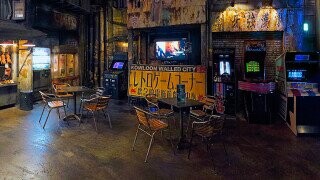The Incredibly Rad 'Walled City' Arcade We Missed Out On

We've previously talked about the Kowloon Walled City, a massive and massively unregulated Chinese city that over a period of nearly a century grew from a regular military fort to the most densely populated and confusing location in the world.

Though it got torn down in 1993, it didn't go away without leaving a lasting impression on pop culture. It shows up not only in numerous classic arthouse films from Asia but also in classic American arthouse films such as Bloodsport.
It also left its eerie mark on video games, as titles with equally weird tales of their own like Garage: Bad Dream, based their entire aesthetic on the mysterious megalopolis. And it goes even further. Enter "Anata no Warehouse," or Kawasaki Warehouse, a Japanese arcade meticulously modeled after the city.



Built-in a five-story building, Anata no Warehouse dedicated three entire floors to precisely replicate the dystopian look and feel of the old place …
… minus the possible tetanus. But then turned it around through the addition of sweet-ass Arcade machines.
Extra points for going for an aesthetic in which getting dirty only adds to the experience.

From a purely aesthetic standpoint, The Kawasaki Warehouse's by far the most weirdly beautiful Arcade ever created.
Words and pictures of chicken can do it no justice, so here's a video:
And before this starts to look way-too-much like a tourist ad, we'll say that if that video and information don't instantly make you go there … Well, good; because you can't. Sadly, this visual testament to Blade Runner's dystopia closed its doors in 2019 for unknown, but hopefully dark and disturbing, reasons. Meaning there's no warehouse called Anata no Warehouse to play haunted games in.
Top Image: Ken Ohyama/Wiki Commons